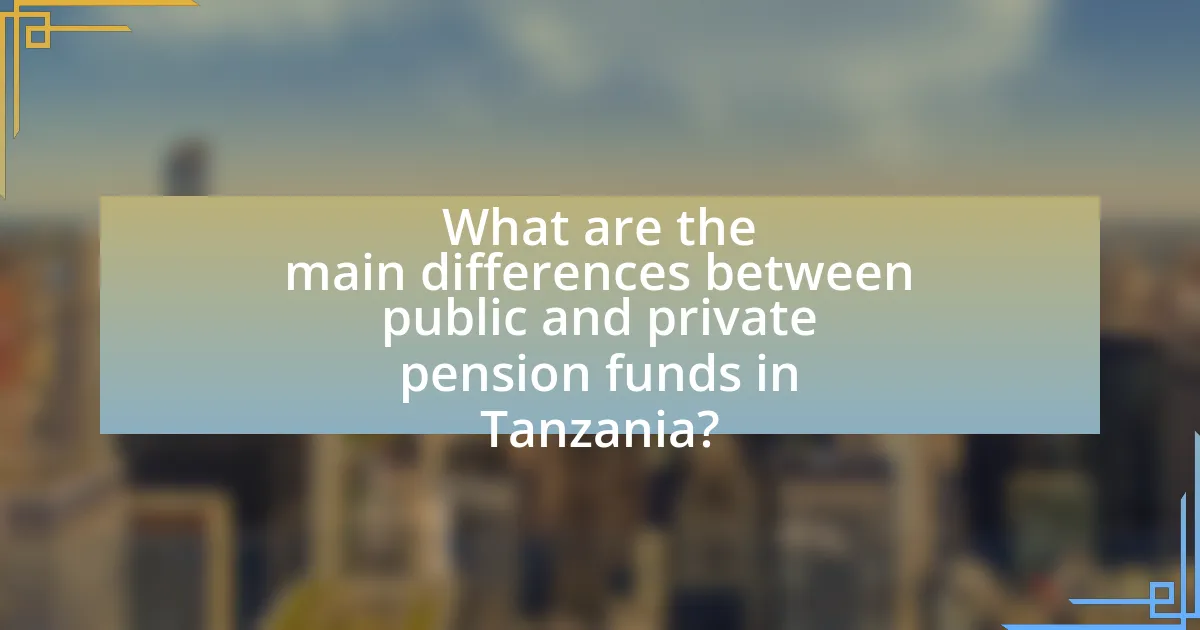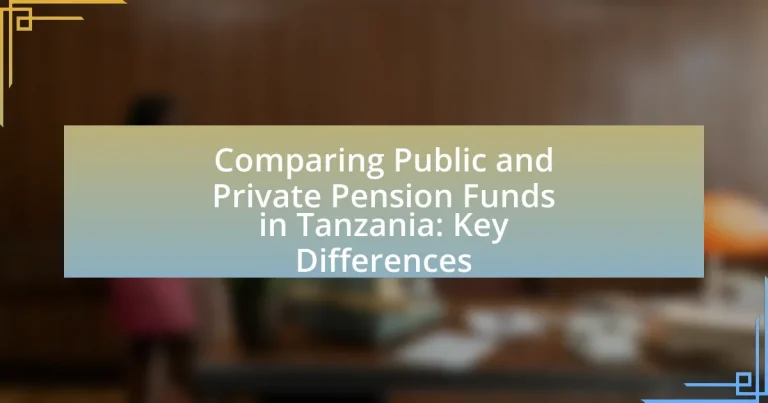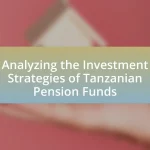The article focuses on the key differences between public and private pension funds in Tanzania, highlighting their distinct characteristics, operational frameworks, and regulatory environments. Public pension funds, primarily government-managed, cater to civil servants with mandatory contributions and defined benefits, while private pension funds, managed by private entities, offer voluntary contributions and defined contribution plans. The article further explores the funding sources, benefits, risks, and investment strategies associated with each type of fund, as well as their impact on the Tanzanian economy and future trends in the sector. Additionally, it discusses best practices for individuals considering their pension options, emphasizing the importance of evaluating fund performance, fees, and regulatory oversight.

What are the key characteristics of public and private pension funds in Tanzania?
Public pension funds in Tanzania are primarily government-managed and cater to civil servants, while private pension funds are managed by private entities and serve employees in the private sector. Public pension funds, such as the Public Service Pension Fund (PSPF), are characterized by mandatory contributions from both employers and employees, offering defined benefits based on salary and years of service. In contrast, private pension funds, like the National Social Security Fund (NSSF), often provide defined contribution plans, where benefits depend on the amount contributed and investment performance. Additionally, public pension funds typically have a larger asset base and are subject to stricter government regulations, while private pension funds enjoy more flexibility in investment strategies. These distinctions highlight the structural differences in how each type of fund operates within Tanzania’s pension landscape.
How do public pension funds operate in Tanzania?
Public pension funds in Tanzania operate under the regulatory framework established by the National Social Security Fund (NSSF) and other statutory bodies. These funds are primarily financed through mandatory contributions from employees and employers, which are typically set at a rate of 10% of the employee’s salary, with the employer contributing an additional 10%. The funds are managed by the NSSF and other pension schemes, which invest the collected contributions in various assets to generate returns for beneficiaries. As of 2021, the NSSF had over 3 million registered members and managed assets worth approximately 4.5 trillion Tanzanian Shillings, demonstrating the scale and significance of public pension funds in the country’s social security system.
What are the main sources of funding for public pension funds?
The main sources of funding for public pension funds are employee contributions, employer contributions, and investment returns. Employee contributions typically involve a percentage of the employee’s salary, while employer contributions are made by the government or public sector employers, often matching or exceeding employee contributions. Investment returns are generated from the fund’s portfolio, which includes stocks, bonds, and other assets, and are crucial for the long-term sustainability of the pension fund. For instance, in the United States, public pension funds rely heavily on investment returns, which accounted for approximately 60% of their total revenue in recent years, highlighting the importance of effective asset management in funding these retirement systems.
What regulations govern public pension funds in Tanzania?
Public pension funds in Tanzania are governed primarily by the Public Service Retirement Benefits Act of 1999 and the National Social Security Fund Act of 1997. These regulations establish the framework for the management, funding, and benefits of public pension schemes. The Public Service Retirement Benefits Act outlines the rights and obligations of both the government and employees regarding retirement benefits, while the National Social Security Fund Act provides guidelines for contributions and benefits for workers in the formal sector. These laws ensure that public pension funds operate within a structured legal environment, promoting transparency and accountability in the management of pension assets.
How do private pension funds function in Tanzania?
Private pension funds in Tanzania operate as voluntary savings schemes that allow individuals to contribute a portion of their income towards retirement. These funds are managed by private financial institutions and are designed to provide additional financial security beyond the mandatory public pension system. Contributions to private pension funds are typically tax-deductible, incentivizing individuals to save for retirement.
The regulatory framework governing these funds is established by the Pension Act of 2008, which mandates that private pension funds must be registered with the Social Security Regulatory Authority (SSRA). This ensures that the funds adhere to specific investment guidelines and maintain a level of financial solvency to protect members’ contributions. As of 2021, there were over 20 registered private pension funds in Tanzania, catering to various sectors and demographics, which highlights the growing importance of private pensions in the overall retirement landscape.
What types of private pension funds are available in Tanzania?
In Tanzania, the types of private pension funds available include occupational pension schemes, individual retirement accounts, and voluntary pension schemes. Occupational pension schemes are established by employers for their employees, while individual retirement accounts allow individuals to save independently for retirement. Voluntary pension schemes provide additional savings options for those who wish to enhance their retirement benefits beyond mandatory contributions. These funds are regulated by the Pension Funds Act of 2008, ensuring compliance and protection for members.
What are the regulatory frameworks for private pension funds?
The regulatory frameworks for private pension funds in Tanzania are primarily governed by the Pension Act of 2008 and its subsequent amendments. This legislation establishes the legal framework for the establishment, management, and regulation of private pension schemes, ensuring that they operate within defined standards for governance, funding, and investment. The National Social Security Fund (NSSF) and the Pension Fund Regulatory Authority (PFRA) oversee compliance with these regulations, which include requirements for fund registration, financial reporting, and member protection. The Act aims to promote transparency and accountability in the management of private pension funds, thereby safeguarding the interests of contributors and beneficiaries.

What are the main differences between public and private pension funds in Tanzania?
Public pension funds in Tanzania are government-managed retirement schemes primarily funded through mandatory contributions from employees and employers, while private pension funds are managed by private entities and often rely on voluntary contributions. Public funds typically offer defined benefits based on salary and years of service, whereas private funds usually provide defined contributions, where the retirement benefit depends on the amount contributed and investment performance. Additionally, public pension funds are subject to government regulations and oversight, while private pension funds operate under the guidelines set by the Pension Act of 2008, allowing for more flexibility in investment strategies.
How do the benefits of public pension funds compare to private pension funds?
Public pension funds generally offer more stable benefits compared to private pension funds. Public pension funds are typically backed by government guarantees, ensuring that retirees receive consistent payouts, while private pension funds are subject to market fluctuations and may not provide the same level of security. For instance, in Tanzania, public pension schemes like the Public Service Pension Fund (PSPF) are designed to provide lifelong benefits to retirees, whereas private pension plans may vary in their payout structures and investment risks. This stability in public funds is crucial, especially in developing economies, where economic volatility can significantly impact private fund performance.
What types of benefits do public pension funds provide?
Public pension funds provide retirement benefits, disability benefits, and survivor benefits. Retirement benefits typically include monthly pension payments based on an employee’s salary and years of service, ensuring financial security in retirement. Disability benefits offer income replacement for members who become unable to work due to illness or injury, while survivor benefits provide financial support to the beneficiaries of deceased members. These benefits are designed to promote economic stability and security for public sector employees and their families.
What types of benefits do private pension funds offer?
Private pension funds offer several types of benefits, including retirement income, tax advantages, and investment flexibility. Retirement income is provided through regular payouts after retirement, ensuring financial stability for individuals. Tax advantages often include tax-deferred growth on contributions and potential tax deductions, which incentivize saving for retirement. Investment flexibility allows individuals to choose from a variety of investment options, tailoring their portfolios to meet personal risk tolerance and financial goals. These benefits collectively enhance the financial security of retirees, making private pension funds an attractive option for long-term savings.
What are the risks associated with public versus private pension funds?
Public pension funds face risks such as political influence and funding shortfalls, while private pension funds encounter market volatility and management risks. Political influence can lead to changes in regulations or funding priorities that jeopardize the stability of public pension funds. For instance, in Tanzania, public pension funds may be subject to government budget constraints, impacting their ability to meet obligations. Conversely, private pension funds are exposed to fluctuations in investment markets, which can affect their asset values and ultimately the benefits available to retirees. According to the World Bank, the performance of private pension funds can vary significantly based on investment strategies and market conditions, highlighting the inherent risks associated with their management.
How do investment strategies differ between public and private pension funds?
Investment strategies between public and private pension funds differ primarily in their risk tolerance and investment horizons. Public pension funds typically have a longer investment horizon and a lower risk tolerance, focusing on stable, long-term returns through diversified portfolios that include government bonds and blue-chip stocks. In contrast, private pension funds often adopt a higher risk tolerance, seeking higher returns through alternative investments such as private equity, hedge funds, and real estate, which can yield greater volatility but potentially higher rewards. This distinction is evident in the asset allocation strategies, where public funds may allocate around 60% to equities and 30% to fixed income, while private funds might allocate a significant portion, up to 40%, to alternative investments to enhance returns.
What are the implications of fund management practices on risk levels?
Fund management practices significantly influence risk levels in pension funds. Effective fund management can mitigate risks through diversification, asset allocation, and active monitoring of investments. For instance, public pension funds in Tanzania often adopt conservative investment strategies, which can lower volatility but may also limit potential returns. Conversely, private pension funds may pursue more aggressive strategies, increasing exposure to market fluctuations and higher risk levels. Research indicates that funds with robust governance structures and transparent management practices tend to exhibit lower risk profiles, as evidenced by the World Bank’s analysis of pension fund performance in developing countries. This highlights the critical role of management practices in shaping the risk landscape of pension funds.

How do public and private pension funds impact the Tanzanian economy?
Public and private pension funds significantly impact the Tanzanian economy by providing capital for investment and enhancing financial stability. These funds contribute to economic growth through infrastructure development, as they often invest in large-scale projects that create jobs and stimulate local economies. For instance, the National Social Security Fund (NSSF) in Tanzania has invested in various sectors, including real estate and energy, which has led to increased employment opportunities and improved public services. Additionally, pension funds help in mobilizing savings, which can be directed towards productive investments, thereby fostering economic development. The presence of these funds also promotes financial literacy and encourages long-term savings among citizens, contributing to overall economic resilience.
What role do pension funds play in national economic development?
Pension funds play a crucial role in national economic development by mobilizing long-term savings for investment in infrastructure, businesses, and financial markets. These funds provide capital that can stimulate economic growth, create jobs, and enhance productivity. For instance, in Tanzania, pension funds have been instrumental in financing large-scale infrastructure projects, which are essential for improving the country’s economic landscape. According to the National Social Security Fund (NSSF) of Tanzania, pension funds have invested significantly in sectors such as real estate and energy, contributing to national development goals. This investment not only supports immediate economic activities but also fosters sustainable growth by ensuring that savings are effectively channeled into productive uses.
How do pension funds contribute to capital markets in Tanzania?
Pension funds contribute to capital markets in Tanzania by providing a significant source of long-term capital for investments. These funds, which manage the savings of workers, invest in various financial instruments such as government bonds, equities, and real estate, thereby enhancing liquidity and stability in the capital markets. For instance, as of 2021, pension funds in Tanzania held assets worth approximately 4.5 trillion Tanzanian Shillings, which accounted for about 10% of the total market capitalization on the Dar es Salaam Stock Exchange. This investment activity not only supports economic growth but also helps in the development of infrastructure projects, thereby fostering overall financial market development in the country.
What is the impact of pension funds on employment and social security?
Pension funds significantly impact employment and social security by providing financial stability for retirees, which in turn influences labor market dynamics. When pension funds are robust, they enhance social security systems by reducing poverty rates among the elderly, thereby allowing older individuals to retire comfortably and exit the workforce. This transition can create job openings for younger workers, stimulating employment growth. Additionally, pension funds contribute to economic stability by investing in various sectors, which can lead to job creation and increased social security contributions. For instance, in Tanzania, the growth of pension funds has been linked to improved social security outcomes, as evidenced by a reduction in the dependency ratio among retirees, allowing for a more sustainable labor market.
What are the future trends for pension funds in Tanzania?
Future trends for pension funds in Tanzania include increased regulatory reforms, diversification of investment portfolios, and a growing emphasis on financial technology. Regulatory reforms are expected to enhance transparency and governance, as the government aims to strengthen the pension sector’s stability. Diversification of investment portfolios will allow pension funds to seek higher returns by investing in various asset classes, including real estate and infrastructure projects. Additionally, the adoption of financial technology will facilitate better access to pension services and improve efficiency in fund management, reflecting a global trend towards digitalization in financial services.
How is the demographic shift affecting pension fund structures?
The demographic shift is significantly affecting pension fund structures by increasing the ratio of retirees to active workers, which strains the financial sustainability of these funds. As life expectancy rises and birth rates decline, the number of beneficiaries grows while the workforce contributing to pension funds diminishes. For instance, in Tanzania, the dependency ratio is projected to rise, leading to increased pressure on both public and private pension systems to meet their obligations. This demographic trend necessitates reforms in pension fund management, investment strategies, and benefit structures to ensure long-term viability and adequacy of pensions.
What innovations are emerging in the pension fund sector in Tanzania?
Innovations emerging in the pension fund sector in Tanzania include the adoption of technology-driven solutions such as mobile applications for contributions and account management, as well as the implementation of digital platforms for investment tracking. These advancements aim to enhance accessibility and transparency for members. For instance, the National Social Security Fund (NSSF) has introduced a mobile app that allows users to manage their accounts conveniently, reflecting a shift towards digitalization in the sector. Additionally, the integration of data analytics is being utilized to optimize investment strategies and improve fund performance, demonstrating a commitment to modernizing pension fund operations in Tanzania.
What best practices should be considered when choosing between public and private pension funds?
When choosing between public and private pension funds, it is essential to evaluate factors such as fund performance, fees, regulatory oversight, and the level of benefits provided. Public pension funds often benefit from government backing, which can lead to more stable funding and lower fees, while private pension funds may offer higher potential returns but come with higher risks and fees.
Additionally, understanding the investment strategies employed by each type of fund is crucial; public funds typically invest in a diversified portfolio with a long-term focus, while private funds may pursue more aggressive investment strategies. Research indicates that public pension funds in Tanzania have historically provided more consistent returns due to their larger asset bases and lower administrative costs compared to private funds.
Ultimately, assessing the specific needs and risk tolerance of the individual investor, along with the historical performance and fee structures of the funds, will guide the decision-making process effectively.





